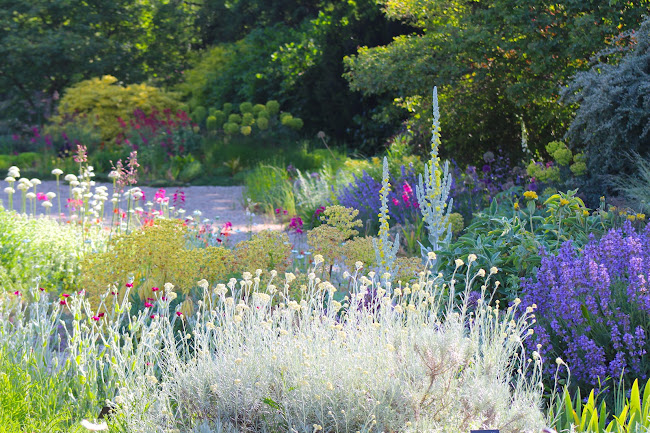As gardeners we are constantly looking at the forecast and sucking our teeth at the varying percentages indicating the probability of rain. We know better than to trust weather charts and water our gardens anyway. I am sometimes told by passersby that I don’t have to water because it is going to rain, or they point out that it is already raining. Yeah. Right. I ignore the advise as I know that even if it did rain, the rainfall would often scarcely penetrate the top centimeter of soil and my plants will remain thirsty. Last summer we experienced severe drought and the gardens at Randall’s Island Park Alliance struggled. Irrigation systems are in place on the lawns and the numerous sports fields, but our gardens, meadows, woodland and green street landscapes have to be watered by hand. This year, with a winter that felt more like Spring and a Spring that felt like Summer at times, many plants are stressed. It is now early Summer and the horticulture staff is out watering some area or the other, almost daily. Rainfall is a bonus. Never count on it. Whether we like it or not, our planet is getting hotter and water is becoming scarce in many places. Gardeners everywhere, may be forced to rethink the way we garden.
This chalkboard stands at the entrance to the Beth Chatto gardens. I think it is a good idea to make similar recordings of rainfall and also note average monthly temperatures for gardens in New York.
Beth Chatto was a garden designer and plantswoman who understood this when she designed her Gravel Gardens on the extremely arid landscape of Colchester in southeast England. The gardens were inspired by a 1989 trip with fellow gardener and friend Christopher Lloyd to New Zealand, where both gardeners recognized many of the plants they found growing wild and untended on rocky slopes. Another source of inspiration came from the garden at the home of the producer Derek Jarman, in Dungeness, Kent, which lies on the southeast coast of England. Situated on sun-scorched, hostile terrain, Derek had managed to create a unique whimsical and drought tolerant garden adorned with rusted and found objects, many of which were washed up from the sea. Beth was intrigued to find poppies, foxgloves, santolina and other silver-leafed plants thriving in gravel, just a few feet from the ocean. The effect was awe-inspiring. Thrilled by what she saw, Beth set out to experiment with plants suited to the conditions of the environment in which they stood, emphasizing the mantra of “match the right plant to the right place”. The experiment evolved into some of the most beautiful and inviting gardens I have ever experienced.
Antennaria, geranium, campion, euphorbia with vertical verbascum, nepta, Gladiolus, and allium in the background.
Species tulips dwelling among antennaria, rose campion and gladious.
This deep pink-mauve Gladiolus byzantine was a stand-out in this and the gardens of Christopher Lloyd at Great Dixter and at Sissinghurst. Here it grows with red valerian (Centranthus ruber), a common roadside plant all over England in June.
Plants with silvery-green, woolly or fuzzy surfaces, like antennaria, stachys, mullein and lychnis are drought tolerant. These plants trap moisture with their fine hairs and their color reflects sunlight.
Sedums and portulacas hold moisture in their fleshy leaves. Crocosmia, gladiolus, geranium, papaver, salvias, euphorbias and Verbena bonariensis, all native to drier, hotter climates, are great choices for the sunny gravel garden.
Although Beth Chatto is best known for her beautiful Gravel Gardens, there were other stunning garden typologies to explore nearby. As we wandered along the meandering paths we encountered much loveliness in the form of water gardens, shade gardens and woodland landscapes on the grounds around the house Beth shared with her husband Andrew.
The gardens were filled with bird talk and activity. It took some research to discover that the weird bird I spied was indeed wagging its tail. It was a wagtail (Motacilla alba), and it wagged away while picking at grubs in the grass near the water gardens. Dragonflies zipped past us and butterflies flirted with flowers.
Circling back, we walked again through the gravel gardens. I was amazed to think that these lush and colorful plantings were only watered once, when they were first installed in 1992. As the announcement was made that the gardens were closing for the day I found it was difficult to say goodbye to this magical place. Thank you, Beth Chatto. Lessons noted.



















